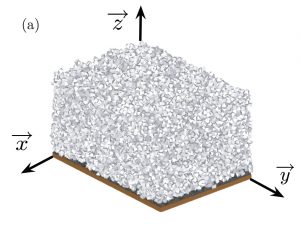Emilien Azéma, Yannick Descantes, Nicolas Roquet, Jean-Noel Roux and François Chevoir, PHYSICAL REVIEW E 86, 031303 (2012)

Samples of 19 000 polyhedra
The influence of grain angularity on the properties of dense flows down a rough inclined plane are investigated. Three-dimensional numerical simulations using the nonsmooth contact dynamics method are carried out with both spherical (rounded) and polyhedral (angular) grain assemblies. Both sphere and polyhedra assemblies abide by the flow start and stop laws, although much higher tilt angle values are required to trigger polyhedral grain flow. In the dense permanent flow regime, both systems show similarities in the bulk of the material (away from the top free surface and the substrate), such as uniform values of the solid fraction, inertial number and coordination number, or linear dependency of the solid fraction and effective friction coefficient with the inertial number. However, discrepancies are also observed between spherical and polyhedral particle flows. A dead (or nearly arrested) zone appears in polyhedral grain flows close to the rough bottom surface, reflected by locally concave velocity profiles, locally larger coordination number and solid fraction values, smaller inertial number values. This dead zone disappears for smooth bottom surfaces. In addition, unlike sphere assemblies, polyhedral grain assemblies exhibit significant normal stress differences, which increase close to the substrate.